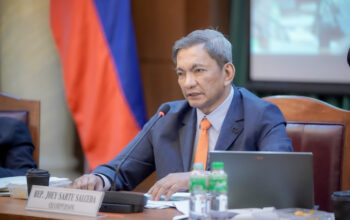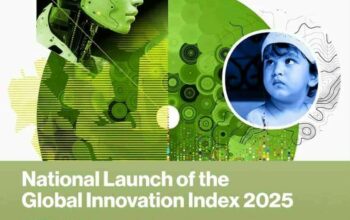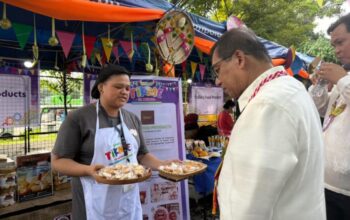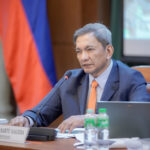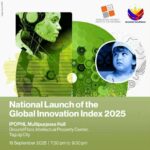LEGAZPI CITY – Albay 2nd District Rep. Joey Sarte Salceda said his ‘Global Albay’ vision for progress takes off in this city of over 200,000 people. Legazpi is Albay’s provincial capital and Bicol’s regional center, the “capacity for greatness of which measures the entire province’s capacity for greatness.”
During the recent launch of his return campaign bid Albay governorship at the fully packed Legazpi Sawangan Park here, Salceda said Legazpi City is destined for greatness, and provides direction for Albay’s drive towards progress.
“Legazpi provides jobs for our people, markets for our products, credit for our businesses, and schools for our young and gifted; It is the window to the soul of the people of Albay. The people’s first view of Legazpi is their first impression of Albay,” he pointed out.
Salceda said Legazpi City’s image, perched along the historic shoreline of Albay Gulf, where vestiges of American occupation can still be traced, with the beautiful Mayon Volcano in the background, greets visitors every day. “Legazpi’s capacity for greatness reflects Albay’s capacity for greatness. “There is no ‘Global Albay’ if there is no ‘Noble Legazpi,’” added Salceda, a respected economist.
He said Legazpi is destined for greatness ever since, noting that the Albay Chamber of Commerce and Industry based here, is the second oldest chamber of commerce in the Philippines on account of Albay’s rich abaca industry; It was also earlier acclaimed as the ‘Cleanest City’ in the Philippines; was made the Bicol Region’s Administrative Capital; and became the center of Bicol Arts and Culture.
Over the past two decades, he observed, “when the visions of our leaders aligned, Legazpi experienced an unprecedented infrastructure boom, through the shared efforts of local leaders and representatives on the national stage.
“For my part, we opened new roads linking Legazpi to its suburbs and neighboring towns, farms to urban centers, the new Albay International Airport (BIA), and tourism sites; we also expanded the capacity of the Bicol Regional Hospital and Medical Center (BRHMC), put up the Bicol Cancer Center and Bicol Heart Center, and established the Bicol University College of Medicine,” he shared.
“We likewise modernized the Bicol University’s facilities, renamed and enlarged the Legazpi City National High School, and built social infrastructure such as 58 covered courts, health facilities, 140 classrooms, and evacuation centers. Rising from the devastation of super Typhoon Reming, when I became Governor, we weathered dozens of subsequent storms with zero casualties. We also survived COVID-19, with one of the best pandemic responses in the country,” he added.
Salceda said Legazpi gained immensely from being the regional city with the largest number of representatives in Congress — six congressmen at one time. I now thus ask that we all be united and help each other so we can bring back the old glory and again be an economic hub of national and international commerce, he urged his constituents.
“With your mandate, I will finish what we have began and start new initiatives to make Albay and Legazpi truly global with more international flights; strengthen Legazpi as foreign tourists’ gateway to the Almasor (Albay-Masbate-Sorsogon) Tourism Circuit, and build the Legazpi Global City at the old domestic airport with a Bicol International Sports Stadium as centerpiece,” he said.
“We will intensify efforts to fix Legazpi’s water facilities with an initial P385-million budget. We will also prepare Legazpi for greater and more and investments, with the Albay Electric Cooperative modernization (now being implemented with a budget of P1.2-B) to stabilize supply and reduce systems loss, to help power rates. These are significant steps towards the realization of our goal to make Legazpi the first Highly Urbanized City of Bicol,” he stressed.
Albay will soon become a renewable energy powerhouse with its existing 250MW Tiwi and 150MW Manito geothermal plants, the ongoing 17MW in Cale, and the 29MW similar facility in Nagotgot; the newly approved 50MW and 30MW Malinao and Kayabon, geothermal facilities, respectively; and the approvals of the 99MW wind farms in Bololo-Tiongson, and 150MW Alternegy, a new entrant.
“With our UNESCO’s Man and Biosphere inscription, we must proactively work to keep them while vigorously campaigning for our bid to place Mayon Volcano in the World Heritage List,” he urged Albayanos.
Salceda said his ‘Global Albay’ vision also includes the following: 1)Bring back to life the Ibalong, Daragang Magayon, Cagsawa and other local festivals to make Albay a Planet Festival; 2) Invest in creative industries and bring out the core of the province’s unique heritage including Culinaria Albay, painting and sculpture and other visual arts where Albayanos are competitive; 3) Strengthen Legazpi as the center of Bicol commerce through the containerization of the Legazpi City, Tabaco City, and Pantao Ports;
4) Restore Legazpi as the Convention Capital of Southern Luzon; and sports, cultural and heritage center of Bicol; 5) Institutionalize it as the University City of Bicol, by strengthening the Bicol University, Smart Campus. BU College of Engineering Laboratory, and BU FabLab Modernization, and bring back their scholarship programs to enhance access to quality tertiary education, both collegiate and techvoc;
6) Make Legazpi as Bicol’s center of world-class healthcare through a Global Hospital at BRHMC, while mobilizing funds from MAIP and Philhealth to give the people easy access to quality healthcare; 7) Revitalize the primacy of LGUs in disaster in disaster risk reduction and climate change adaptation advocacy; and
8) Support local institutions and experts in their action research undertakings and transformative work by revitalizing the Climate Change Academy, LCCAD and strengthening Apsemo, while restoring robust relationships with the CCC and OCD, INGOs (IFRC) and local NGOs (PDRF, PRC), and partner bilateral institutions like AECID, JICA, KOICA, GIZ; and multilaterals such as UN family (OCHA, UNDRR, UNFCCC, GCF).



